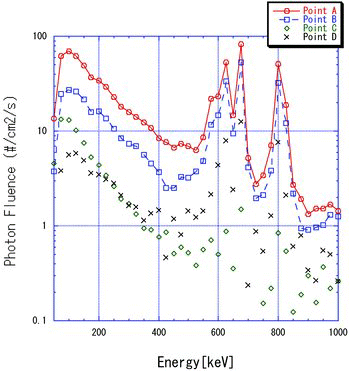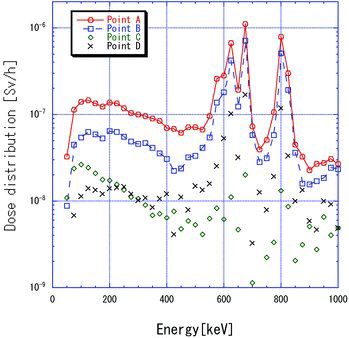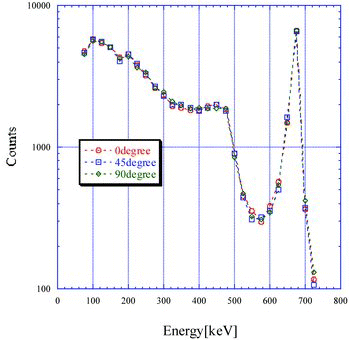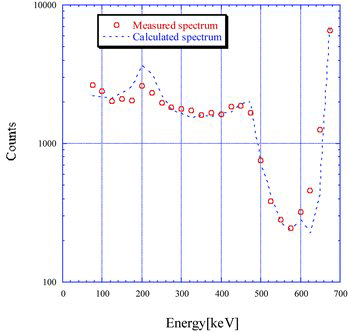Abstract
After the accident of the Fukushima Daiichi Nuclear Power Plant, radionuclide were spread out over large area. It has been past almost two years since the nuclear accident. Therefore, Cs-137 and Cs-134 nuclei are the main sources of gamma rays. The field gamma rays, however, are not mono-energy due to photons scattered from the ground, the air, etc. The effective dose for external exposure depends on the energy of radiations, thus photon energy spectra are important for the evaluation of effective dose for the people who live in Fukushima. In the present study, the photon energy spectra have been measured at several points in Fukushima to evaluate reference energy spectra after the nuclear accident. The energy spectra in Fukushima area were measured using a cadmium zinc telluride (CdZnTe) detector, and an unfolding method was applied to evaluate photon energy spectra. The fraction of low-energy photon is increased by decontamination around the measurement point. This can be used to estimate the efficiency of decontamination effect by removing the radionuclides on the target surface. The photon energy spectra measured by the present study would be useful for the evaluation of the effective dose for the people who live in Fukushima.
1. Introduction
After the accident of the Fukushima Daiichi Nuclear Power Plant, radionuclide were spread out over large area [Citation1]. The International Commission on Radiological Protection (ICRP) [Citation2] recommends that radiation monitoring system is important to assess current levels of human exposure and environmental levels of contamination. It has been past almost two years since the nuclear accident. Therefore, Cs-137 and Cs-134 nuclei are the main sources of gamma rays [Citation3]. The field gamma rays, however, are not mono-energy due to photons scattered from the ground, the air, etc. This may be one of the reasons that different dose meters show different dose rate at a same point. The information of photon spectra is very important to estimate the accuracy of dose rates measured results using various detectors. And the effective dose for external exposure depends on the energy of radiations [Citation4], so photon energy spectra are important for the evaluation of effective dose in Fukushima area.
In the present study, the photon energy spectra have been measured at several points in Fukushima to evaluate reference energy spectra after the nuclear accident. The decontamination of radioactive material is ongoing for houses, parks, loads, farm lands, etc. It is expected that the photon energy spectrum will change due to the decontamination effects. Therefore measurement points in present study are selected at both of non-decontaminated and decontaminated area.
2. Spectra measurements
2.1. Detector
A CdZnTe detector (GR1) manufactured by Kromek Limited was used for present study. This detector unit consists of a CdZnTe semiconductor, a preamplifier, a shaping amplifier, a pulse height digitizer, and a high voltage supply. The unit is powered entirely from the universal serial bus (USB). The size of the CdZnTe is 1 cm×1 cm×1 cm cubic. The photons in the fields after the Fukushima nuclear accident occur mainly from the ground as the radionuclides had fallen onto the ground. Hence the detector for measuring field spectrum should have no angular dependence of at least for 2π directions. Although a small amount of scattered gamma rays comes from the sky, it is negligible for the present study.
Pulse height distributions were measured with the CdZnTe detector mounted at the angles of 0°, 45°, and 90° from Cs-137 gamma rays direction to evaluate the angular dependence of the detector as illustrated in . shows the results of the angular dependence, and there is no difference among the spectra at the different angles. This shows that the detector has no angular dependence over 2π angles.
2.2. Unfolding with response function
An unfolding method with response functions calculated using EGS5 [Citation5] code for the GR1 detector was applied to obtain the photon energy spectrum from measured energy spectrum data. An inverse matrix method was applied for this unfolding. shows a measured spectrum for Cs-137 gamma rays and simulated one. The effective volume of the CdZnTe detector was adjusted so that the calculated response function fit the measured spectrum. The measured and simulated spectra are almost the same. The response functions were calculated for the energies from 25 to 800 keV with 25 keV steps interval. To ensure the accuracy of unfolding and response function, X-ray spectra were measured using the detector. The ambient dose rates obtained from the spectra are shown in together with those measured by using a reference ionization chamber for each beam condition. The ambient dose rates obtained by the CdZnTe detector agree with the reference dose rates within 10%.
Table 1. Comparison of ambient dose rate at the National Metrology Institute of Japan (NMIJ) reference X-ray fields.
2.3. Measurements of field energy spectra in Fukushima
The field energy spectra were measured at Iidate village and Fukushima city to observe the differences at typical conditions. The conditions of the measurement points are described in . Point A is the highest dose rate point near by the off-limit area. Point B shows the ambient dose rate at the height of 1 m from the ground surface of a schoolyard, and point C also shows the ambient dose rate the ground of school that was decontaminated. These two areas (points B and C) were chosen to compare the effect of decontamination. Point D is located in a center of Fukushima city that is surrounded by buildings and its ground is covered with asphalt and concrete. Points A and D location were chosen to observe the effect of condition around measurement points. The detector was set at 1 m height and mounted facing the ground so that photons from the ground below the detector and those from the side area can be detected completely. The dose rate due to photons from the upper side is expected to be small and can be neglected.
Table 2. Information of measurement points.
The ambient dose rates were also measured using a well calibrated NaI(Tl) survey meter (TCS-172: Hitachi Aloka Medical Inc.) to compare the values obtained by the spectrum measurements.
3. Results
The fluence spectra measured at several points listed in are shown in . Ambient dose spectra, which were obtained from the fluence spectra, are also shown in . The spectrum obtained at point C is different from other spectra in low-energy region. It is clear that the energy spectrum of field photons changes by decontamination around the measurement point. shows the total dose rates obtained by measurements with the CdZnTe detector and the NaI(Tl) survey meter. It also shows ambient dose rates for three energy regions (below 250, 250–500 and above 500 keV). These were estimated from the energy spectra measured with the CdZnTe detector. The total ambient dose rates obtained by measurement with the CdZnTe detector and that by the NaI(Tl) survey meter agree well with a difference less than 10%. The ambient dose rate due to low-energy photons at point C (decontaminated around the measurement point) is quite large compared with those at other points. The percentage of the Cs-134 and Cs-137 gamma rays decreases by decontamination. It is possible that the primary gamma rays of Cs-137 and Cs-134 reach only from near area (several 10 m) and scattered photons come from far area. This implies that the surrounding air may act as scattering material.
Table 3. Measured ambient dose rate using CdZnTe detector and NaI(Tl) survey meter. Italic value means a ratio of each energy region against a total dose.
Figure 4. Normalized photon flux at each point. Flux is normalized at the peak of Cs-137 gamma rays.

Figure 5. Normalized ambient dose rate distribution at each point. Dose rate is normalized at the peak of Cs-137 gamma rays.

From the data of points A, B, and D, it can be said that the shape of spectra at the non-decontaminated area is similar. This is because the energy spectra changed due to decontamination.
4. Conclusion
The energy spectra in Fukushima area were measured using a CdZnTe detector. The photon spectra at non-decontaminated area were almost the same. The fraction of low-energy photon is increased by decontamination around the measured points. The photon energy spectra measured by the present study would be useful for the evaluation of the effective dose for those living in Fukushima. This can also be used to estimate the efficiency of decontamination removing the radionuclides on the target surface.
Survey meters should be carefully selected for the measurement of dose rates to evaluate the effect of the decontamination. It is important to obtain correct values of dose rates by using a survey meter which has no energy dependence.
References
- Distribution map of radiation dose around Fukushima Daiichi & Dai-Ni NPP by the MEXT. Tokyo, Japan: MEXT [accessed 2013 February 7]. Available from: http://www.mext.go.jp/english/incident/1305901.htm
- Application of the Commission's recommendation to the protection of people living in long-term contaminated area after a nuclear accident or a radiation emergency. ICRP Publication 111; 2009.
- Readings of environmental monitoring samples in Fukushima Prefecture by the MEXT. Tokyo, Japan: MEXT [accessed 2013 February 7]. Available from: http://www.mext.go.jp/english/incident/1307583.htm
- Conversion coefficients for use in radiological protection against external radiation. ICRP Publication 74; 1997.
- Hirayama H, Namito Y, Bielajew AF, Wilderman SJ, Nelson WR. The EGS5 code system. Japan: High Energy Accelerator Research Organization; 2005 (KEK Report 2005–8).



